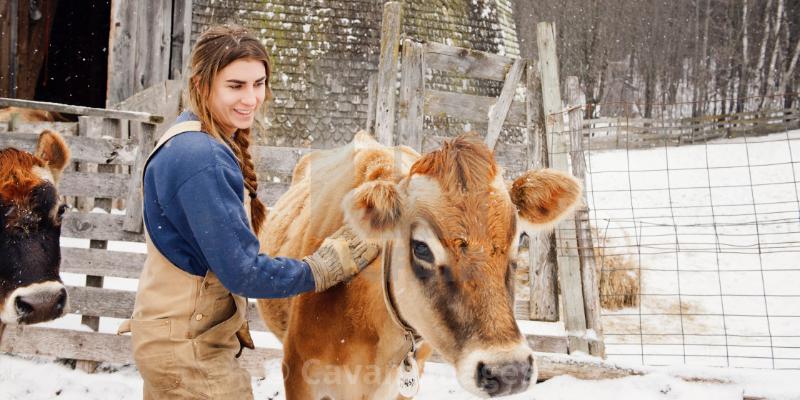-
February 11, 2021

- • Featured • Announcements
Why Don't Cows Need Coats?
As you drive through the countryside during this chilly season, you may be wondering why the cows out in the pasture or standing in the outdoor paddock aren’t all bundled up…? You may even feel sad for them, as you see their breath, thinking that they must be cold and uncomfortable. However, did you know that cows are happiest during the chillier months of the year here in New York State?
 This is Farmer Jake from Appleridge Farm helping with calf chores.
This is Farmer Jake from Appleridge Farm helping with calf chores.
Research and numerous studies from a variety of universities in the Northeast have been done to find out the temperatures and weather conditions cow prefer. Many of these studies have concluded that the dairy cattle found in our region of the world are happiest between 25 – 65-degree weather! Now, that may not be where the farmer thrives, but thankfully Carhartt and Under Armor can help with that!
So how then did the researchers and the farmers know that their cows are happy and thriving in such low temperatures? Well, fortunately there are a few visible signs that can cows portray that show farmers they are doing just fine.
-The first sign that the animals are warm enough can be detected by a simple visual look-over. The cows are maintaining a healthy body condition, meaning they aren’t losing weight and are not cold or uncomfortable. If an animal is cold, their body will shiver in an attempt to create friction and heat. The shivering actually burns more calories causing the animal to lose weight. The heavy winter coat of hair and thick hide help to protect dairy cattle against snow and freezing temperatures. These natural barriers along with barns and clean, dry bedding keep out the winter chill.
-Another visual sign that cows are not too cold, is seeing that they are actively chewing their cud. A cud is a baseball sized lump of food that a cow regurgitates to chew again to aid in digestion. Cows will only chew their cud however when they feel safe, relaxed, and are comfortable. If a cow isn’t warm enough or is uncomfortable, she won’t be using her energy to chew her cud. Instead, her body would be attempting to conserve energy to keep her warm. So next time you are driving by a farm, take a quick look to see if the cows are laying down and look to be chewing on something. They are chewing their cud, and now you know they are comfortable.
-One final way farmers know their herd is warm enough is by looking for major fluctuations in the amount of milk a cow is producing. Cows naturally produce milk after they have a calf but, milk production tends to increase when they are comfortable, healthy, well fed, and feel safe. Cows that may feel they need to conserve energy to maintain their own health for whatever reason, will decrease in milk production and could even “dry up” or stop producing milk all together. Because of this, dairy farmers make every effort to maintain their herd’s health and comfort throughout the bitter months. More often than not, farmers actually see increases in their herds milking averages as temperatures cool off and the heat of the summer fades into fall and winter.

So, don’t feel sorry for the cows out in the cold, they are actually loving it. Instead, think about the farmers who are also out in the freezing weather, all bundled up in numerous layers of clothing, caring for their herd. They are the ones we should be checking on and bringing a hot cup of coffee!
